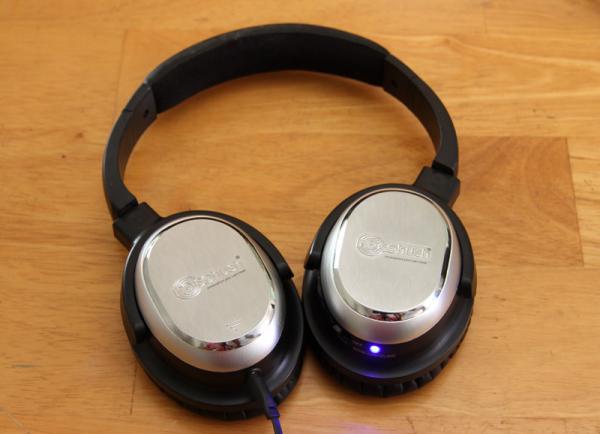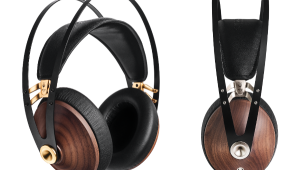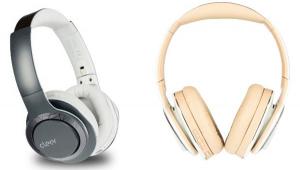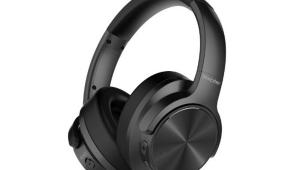Review: NoiseHush i7

Noise-cancelling headphones shouldn't be so expensive. In most cases, the technology is simple: a couple of tiny microphones, a cheap amplifier chip, and a simple filter circuit. Yes, the industry-leading, $299 Bose QC-15 uses a more sophisticated design, but it's always seemed to me that someone ought to be able to create a decent knock-off, something that delivers pretty good noise cancelling and pretty good sound for maybe $99. Yet the inexpensive NC headphones I've tried from such companies as AudioTechnica, Creative Labs, and Tivoli Audio didn't cut it for me; they suffered from some combination of insufficient volume, so-so sound, and uncomfortable ergonomics.
Two relatively recent entrants into the headphone biz-NoiseHush and Monoprice-are now attempting to be the first to deliver a viable, ~$100 alternative to the QC-15. Today we'll listen to the $99 NoiseHush i7. On Wednesday, we'll check out the $112 Monoprice 10010.
The i7 is clearly "inspired by" the QC-15; it looks almost the same but for its ungapatschka, fake-brushed-aluminum plastic side panels. It has a detachable cable so you can use it just for the noise cancelling function, and it comes with a slim semi-hardshell travel case. Two AAA batteries power the NC circuitry. The cable includes an inline microphone for use with your smartphone; the mike includes a play/pause/answer button.
On closer inspection, important differences emerge. The i7 has a side-mounted volume knob-a real old-fashioned analog potentiometer, not a digital encoder. While the knob looked like something you'd find on a 1970s-vintage headphone, I loved the precision volume adjustment it allowed; a rare treat in these days of up/down volume buttons with +/-2 dB steps. Also, the i7 works in passive mode, with the noise cancelling switched off, so you don't lose sound when the batteries run down, as you do with the QC-15.
i7 meets MD-80
I had the occasion to take both the i7 and the Monoprice 10010 into perhaps the loudest place on any commercial airliner: the rear section of one of American Airlines' battered, soon-to-be-replaced MD-80 jets, sitting only 6 feet or so from the intake of the plane's side-mounted engines. It's a tough trial for a noise-cancelling headphone. I also did extensive in-home testing of both models, aided by frequent West Coast headphone tester Will Huff, as well as by a headphone company head who'd stopped by to see if I could measure some prototypes for him (all of his gear is at the factory in China).
So how'd a headphone powered by two AAA batteries fare against an airliner powered by two 20,000-pound-thrust engines? Pretty well. The i7's noise-cancelling function gave me a nice respite from the jet's roar, so much so that I removed it for only a couple of minutes of the entire three-hour LAX-to-DFW leg of my trip. It wasn't the incredible "cone of near-total silence" feel you get with the QC-15, but it was far better than I've experienced with any other noise-cancelling headphone anywhere near this price.
The i7's earpads, which the company's site says are made from leather and memory foam, also held up well; the only discomfort I experienced was a slight rubbing of the cloth covering the drivers against my earlobes, which began to annoy me just a bit after about 2 hours. Nothing a 5-minute listening break couldn't fix.
One the plane, I noted the i7's sound as "fine," meaning that I was able to enjoy the various pop, metal, and jazz cuts I listened to without being distracted by obvious tonal colorations. Against the partially cancelled hum from the jet engines, the i7 seemed to have a fairly flat balance with the noise cancelling activated. Whether it was the pulsating bass of the English Beat, the dense pop of Toto, the intense heavy metal of Celtic Frost, the delicate flute musings of Charles Lloyd, or the spiritual soul/funk of Meshell Ndegeocello, I found myself getting wrapped up in the music, my head bobbing frenetically enough to get the woman next to me wondering what I was up to, prompting her to ask (to her eventual chagrin, I'm sure) why I was carrying so many sets of headphones.
In the more demanding and quiet environment of my home, the i7's tonal colorations in NC mode became obvious. The midrange sounded sucked out, so much so that Toto's "Rosanna" seemed less like a super-slick pop production and more like a melange of kick drum, bass guitar with everything below 80 Hz filtered out, thin-sounding vocals, and phasey-sounding snare drum.
The good news is that there's an easy fix: Just shut off the NC when you're at home. In a quiet environment with the NC off, the i7 sounds quite nice, with a mostly neutral tonal balance and just the slightest bit of lower-treble emphasis. "Rosanna" suddenly sounded right: not as lively, detailed, and smooth as it would through a really great set of headphones, but pleasing nonetheless.
My other listeners agreed that the i7's sound in noise-cancelling mode didn't work well in the quiet surroundings of my home. Will complained, "The upper octaves were piercing and the sound was unmusical overall. It feels like it's overpowering the drivers." But while Will felt that the sound "lacked pop and sparkle" in passive mode, the visiting headphone company guy (who insists on remaining anonymous) was a bit blown away. "I can't believe how flat [i.e., even] these sound in passive mode and how uneven they sound with the noise cancelling on," he said. "Usually it's the other way around."
Measurements
I measured the performance of the i7 using a G.R.A.S. 43AG ear/cheek simulator, a Clio FW audio analyzer, a laptop computer running TrueRTA software with an M-Audio MobilePre USB audio interface, and a Musical Fidelity V-Can headphone amplifier. Measurements were calibrated for ear reference point (ERP), roughly the point in space where your palm intersects with the axis of your ear canal when you press your hand against your ear. I experimented with the position of the earpads by moving them around slightly on the ear/cheek simulator, and settled on the positions that gave the best bass response and the most characteristic result overall.
The frequency response measurements suggest radically different performance in NC and passive modes. In passive mode, the response is nearly flat. NC mode adds a huge bass boost between 40 and 200 Hz, and a huger upper-midrange boost between 1 and 3.5 kHz. Adding 70 ohms output impedance to the V-Can's 5-ohm output impedance to simulate the effects of using a typical low-quality headphone amp has no effect with NC on and only a very slight effect in passive mode. I also measured how the volume knob setting affects frequency response; it merely boosts bass by about +1 dB below 100 Hz. The spectral decay plot shows a strong resonance at 1.8 kHz in NC mode, right where that big peak emerges in the frequency response measurement.
With NC off, isolation is typical for a pair of over-ear headphones. Switching on NC brings the level down -5 to -20 dB between 80 and 800 Hz-not QC-15 performance by a long shot, but enough to deliver a substantial reduction of airplane engine noise. A typical noise-cancelling headphone might add -10 dB of isolation between about 100 and 400 Hz, so this performance is above average.
Total harmonic distortion (THD) is rather high: about 2.5% at 100 Hz in passive mode, jumping to 6% with NC on. This measurement is taken at loud levels, though; I didn't notice this distortion at my usual modest listening level.
Impedance is essentially flat no matter how you use the i7, although the volume control does increase impedance at lower settings-for example, in passive mode it drops from about 120 ohms with volume at minimum to 60 ohms with volume at max. Average sensitivity from 300 Hz to 6 kHz at the rated 32 ohms is 102.5 dB with NC off, 110.0 dB with NC on.
Bottom Line
Is the NoiseHush i7 the first under-$100 noise-cancelling headphone worth buying? I sure think so. Personally, I'd spend the extra $200 for the Bost QC-15, but audio's my thing. For the average person looking for an affordable travel headphone, the i7 is the best choice I've found.
So far, at least. Read my Monoprice 10010 review to find out if the i7's got any serious competition.
- Log in or register to post comments




































































